
Locusts are various species of short-horned grasshoppers in the family Acrididae that have a swarming phase. These insects are usually solitary, but under certain circumstances they become more abundant and change their behaviour and habits, becoming gregarious. No taxonomic distinction is made between locust and grasshopper species; the basis for the definition is whether a species forms swarms under intermittently suitable conditions; this has evolved independently in multiple lineages, comprising at least 18 genera in 5 different acridid subfamilies.

The desert locust is a species of locust, a periodically swarming, short-horned grasshopper in the family Acrididae. They are found primarily in the deserts and dry areas of northern and eastern Africa, Arabia, and southwest Asia. During population surge years, they may extend north into parts of western Spain and southern Italy, south into Eastern Africa, and east in northern India. The desert locust shows periodic changes in its body form and can change in response to environmental conditions, over several generations, from a solitary, shorter-winged, highly fecund, non-migratory form to a gregarious, long-winged, and migratory phase in which they may travel long distances into new areas. In some years, they may thus form locust plagues, invading new areas, where they may consume all vegetation including crops, and at other times, they may live unnoticed in small numbers.
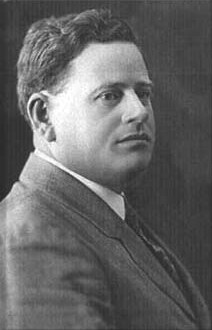
Aaron Aaronsohn was a Jewish agronomist, botanist, and Zionist activist, who was born in Romania and lived most of his life in the Land of Israel, then part of the Ottoman Empire. Aaronsohn was the discoverer of emmer, believed to be "the mother of wheat." He founded and was head of the NILI espionage network.

The American Colony was a colony established in Jerusalem in 1881 by members of a Christian utopian society led by Anna and Horatio Spafford.

Ahmed Djemal, also known as Cemal Pasha, was an Ottoman military leader and one of the Three Pashas that ruled the Ottoman Empire during World War I.

Brummana is a town in the Matn District of the Mount Lebanon Governorate in Lebanon. It is located east of Beirut, overlooking the capital and the Mediterranean. Brummana has long been a summer destination for visitors and locals. It is also the green lung of the region, with many pine trees lining its streets.

Ottoman Syria refers to divisions of the Ottoman Empire within the region of Syria, usually defined as being east of the Mediterranean Sea, west of the Euphrates River, north of the Arabian Desert and south of the Taurus Mountains.
Martyrs' Day is a Syrian and Lebanese national holiday commemorating the Syrian and Lebanese nationalists executed in Damascus and Beirut on 6 May 1916 by Jamal Pasha, also known as 'Al Jazzar' or 'The Butcher', the Ottoman wāli of Greater Syria. They were executed in both the Marjeh Square in Damascus and Burj Square in Beirut. Both plazas have since been renamed Martyrs' Square.

The Mount Lebanon Mutasarrifate was one of the Ottoman Empire's subdivisions following the Tanzimat reform. After 1861, there existed an autonomous Mount Lebanon with a Christian mutasarrıf, which had been created as a homeland for the Maronites under European diplomatic pressure following the 1860 Druze–Maronite conflict. The Maronite Catholics and the Druze founded modern Lebanon in the early eighteenth century, through the ruling and social system known as the "Maronite-Druze dualism" in Mount Lebanon.

Tel Aviv and Jaffa deportation was the evacuation on April 6, 1917, of 10,000 people from Jaffa, including Tel Aviv, by the authorities of the Ottoman Empire in Palestine. Two-thirds of the evacuees were Muslim and Christian, and one third were Jewish. Neither Jaffa-Tel Aviv, nor its Jewish population, had been singled out – the evacuation followed a similar event in Gaza a few months prior ahead of the advance of British forces. However, pro-Zionist propaganda subsequently turned the event into "a cause célèbre".

The Mutasarrifate of Jerusalem, also known as the Sanjak of Jerusalem, was an Ottoman district with special administrative status established in 1872. The district encompassed Jerusalem as well as Hebron, Jaffa, Gaza and Beersheba. During the late Ottoman period, the Mutasarrifate of Jerusalem, together with the Sanjak of Nablus and Sanjak of Akka (Acre), formed the region that was commonly referred to as "Palestine". It was the 7th most heavily populated region of the Ottoman Empire's 36 provinces.
In 2012, Madagascar had an upsurge in the size of its Malagasy migratory locust populations. In November of that year, the government issued a locust alert, saying that conditions were right for swarming of the pest insects. In February 2013, Cyclone Haruna struck the country, creating optimal conditions for locust breeding. By late March 2013, approximately 50% of the country was infested by swarms of locusts, with each swarm consisting of more than one billion insects. The authorities changed the situation to plague status. According to one eyewitness,"You don't see anything except locusts. You turn around, there are locusts everywhere".
The Seferberlik was the mobilisation effected by the late Ottoman Empire during the Second Balkan War of 1913 and World War I from 1914 to 1918, which involved the forced conscription of Lebanese, Palestinian, Syrian, and Kurdish men to fight on its behalf as well as the deportation of 'numerous Lebanese & Syrian & Kurdish families' to Anatolia under Djemal (Cemal) Pasha's orders. Lebanese Syrians and Kurdish men accused of desertion were executed, and some 300,000 of the Arabs and Kurds who stayed behind died in the Lebanon famine, as Lebanon & Syria lost 75 to 90 percent of their crop production. Prostitution and cannibalism were also mentioned in reports or memoirs written after the end of the war.

The Great Famine of Mount Lebanon (1915–1918) was a period of mass starvation during World War I that resulted in 200,000 deaths of largely Christian and Druze inhabitants.

Goodbye, Antoura: A Memoir of the Armenian Genocide is a memoir written by Karnig Panian, and published in English by the Stanford University Press in 2015. The memoir, originally written in Armenian, follows the five-year-old Karnig Panian through the years of the Armenian genocide, through Anatolia and Syria, and finally to the College St. Joseph in Antoura, Lebanon, where the Ottoman Government had established an orphanage to Turkify surviving Armenian children.
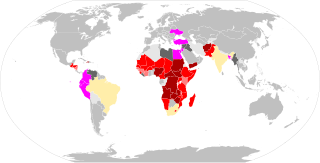
During the COVID-19 pandemic, food insecurity has intensified in many places – in the second quarter of 2020 there were multiple warnings of famine later in the year. In an early report, the Nongovernmental Organization (NGO) Oxfam-International talks about “economic devastation” while the lead-author of the UNU-WIDER report compared COVID-19 to a “poverty tsunami”. Others talk about “complete destitution”, “unprecedented crisis”, “natural disaster”, “threat of catastrophic global famine”. The decision of WHO on March 11, 2020 to qualify COVID as a pandemic, that is “an epidemic occurring worldwide, or over a very wide area, crossing international boundaries and usually affecting a large number of people” also contributed to building this global-scale disaster narrative.
Hunger in Syria is a present-day crisis that has become prominent since the outbreak of the Syrian civil war and exacerbated by the country's efforts to control the spread of the covid-19 coronavirus. The United Nations reported in 2020 that Syria faced "an unprecedented hunger crisis" as food prices had risen by 200 percent within a year with "tens of thousands" at risk of famine in the north-west region of the country, described as "the worst humanitarian crisis since violence broke out in Syria nine years ago". The World Food Program was supporting 4.8 million Syrians in need of food.
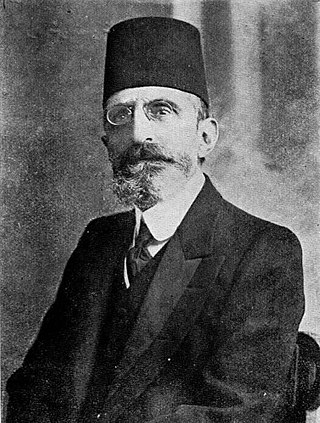
Ohannes Pasha Kouyoumdjian, known as Ohannes Pasha, Ohannes, Ohannes Kuyumcuyan was a high ranking Ottoman Armenian official, and the last mutasarrif of the Mount Lebanon Mutasarrifate from 1912 until his resignation in 1915.
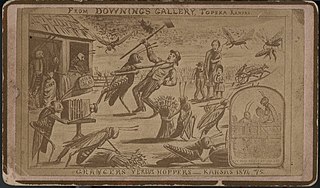
The Locust Plague of 1874, or the Grasshopper Plague of 1874, occurred when hordes of Rocky Mountain locusts invaded the Great Plains in the United States and Canada. The locust hordes covered about 2,000,000 square miles (5,200,000 km2) and caused millions of dollars' worth of damage. The swarms were so thick that they could cover the sun for up to six hours and caused millions of dollars worth of crop damage. Efforts were made to stop the infestation, including eating the locusts. Following the plague, the population of Rocky Mountain locusts continued to decline each year after 1874 and in spring 1875, many of the hatched locust eggs died due to frost, contributing to their eventual extinction.
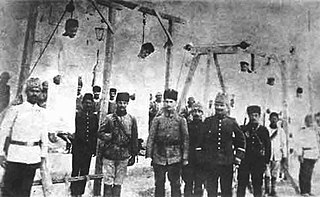
Abdul Hamid al-Zahrawi was a Syrian Arab nationalist and former member of the General Assembly of the Ottoman Empire. A journalist with the Arab newspaper Al Qabas he supported the Committee of Union and Progress (CUP), a Young Turks movement that carried out a successful coup in 1908. Zahrawi sat for the CUP in parliament but turned against them when they started replacing Arab officials with Turks and was replaced in a rigged election in 1912.
















